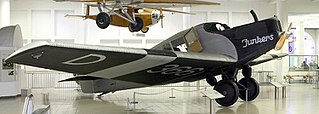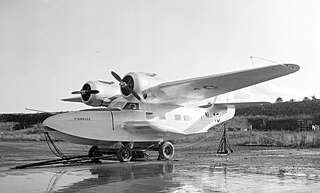
Nielsen & Winther was a Danish machine factory and aeroplane manufacturer based in Copenhagen, Denmark.

Nielsen & Winther was a Danish machine factory and aeroplane manufacturer based in Copenhagen, Denmark.
The machine factory was founded in 1873. It was from 1899 to 1916 based in a building at Blegdamsvej 60 designed by Axel Berg. It then relocated to a new building designed by Frederik Wagner at Ryesgade 51-55 as well as a large new plant at Øresundsvej 147. [1]
The Amager plant was home to a new aeroplane division. It delivered six Nielsen & Winther Type Aa aeroplanes to the Royal Danish Air Force in 1917. [2] One aircraft was delivered to the Royal Norwegian Navy Air Service in 1918. Three of the six Danish aircraft crashed in accidents and the three remaining ones were therefore grounded. The Amager plant was sold to Vølund in 1920. [3]
Aircraft produced by Nielsen & Winther:- Data from A/S Nielsen & Winther [2]
Nielsen & Winther was also the name of a football club founded in 1918 by workers at the factory: [4]
The company's former buildings at Blegdamsvej 60 and Ryesgade 51-55 have survived. The Amager plant, taken over by Vølund, was demolished in 2001. Its premises in the Free Port was taken over by Riffelsyndikatet.

The Curtiss JN "Jenny" was a series of biplanes built by the Curtiss Aeroplane Company of Hammondsport, New York, later the Curtiss Aeroplane and Motor Company. Although the Curtiss JN series was originally produced as a training aircraft for the US Army, the "Jenny" continued after World War I as a civil aircraft, as it became the "backbone of American postwar [civil] aviation".

The Junkers F 13 was the world's first all-metal transport aircraft, developed in Germany at the end of World War I. It was an advanced cantilever-wing monoplane, with enclosed accommodation for four passengers. 322 planes of the type were manufactured, an exceptionally large number for a commercial airliner of the era, and were operated all over the globe. It was in production for thirteen years and in commercial service for more than thirty.

The Avro 504 was a First World War biplane aircraft made by the Avro aircraft company and under licence by others. Production during the war totalled 8,970 and continued for almost 20 years, making it the most-produced aircraft of any kind that served in any military capacity during the First World War. More than 10,000 were built from 1913 until production ended in 1932.

Between 1911 and 1914, the Royal Aircraft Factory used the F.E.2 designation for three quite different aircraft that shared only a common "Farman" pusher biplane layout.

The Vickers F.B.5 was a British two-seat pusher military biplane of the First World War. Armed with a single .303 in (7.7 mm) Lewis gun operated by the observer in the front of the nacelle, it was the first aircraft purpose-built for air-to-air combat to see service, making it the world's first operational fighter aircraft.

The North American P-64 was the designation assigned by the United States Army Air Corps (USAAC) to the North American Aviation NA-68 fighter, an upgraded variant of the NA-50 developed during the late 1930s. Seven NA-50s were purchased by the Peruvian Air Force, which nicknamed it Torito.

The Fokker C.V was a Dutch light reconnaissance and bomber biplane aircraft manufactured by Fokker. It was designed by Anthony Fokker and the series manufacture began in 1924 at Fokker in Amsterdam.

The Flying Flea is a large family of light homebuilt aircraft first flown in 1933.
Luft-Fahrzeug-Gesellschaft, also referred to as LFG, was a German aircraft manufacturer during World War I. They are best known for their various "Roland" designs, notably the Roland C.II Walfisch (whale), Roland D.II haifisch (Shark) and Roland D.VI, although they also produced a number of airships and many experimental designs.

The Farman F.60 Goliath was a French airliner and bomber produced by the Farman Aviation Works from 1919. It was instrumental in the creation of early airlines and commercial routes in Europe after World War I.

Blériot Aéronautique was a French aircraft manufacturer founded by Louis Blériot. It also made a few motorcycles between 1921 and 1922 and cyclecars during the 1920s.

The Norsk Flyindustri Finnmark 5A was an amphibious flying-boat airliner built in Norway in the late 1940s. The single prototype was operated by the VLS airline, but no orders for additional aircraft were received, and a refined version designated 5A-II was never built. The Finnmark was a conventional high-wing cantilever monoplane with twin engines housed in nacelles on the wings, and the first twin-engined aircraft constructed in Norway. A specially-designed combination wheel-ski undercarriage retracted into wide sponsons on the sides of the flying boat hull.
The Nielsen & Winther Type AA, also known as the Type AA, was a Danish fighter aircraft of the 1910s manufactured by Nielsen & Winther in Copenhagen.
Halberstädter Flugzeugwerke or Halberstadt was a German aircraft manufacturer. It was formed on 9 April 1912 under the name Deutsche Bristol Werke Flugzeug-Gesellschaft mbH in Halberstadt, Province of Saxony.

The Cody V was a single-engined biplane built by the British-based American aviation pioneer Samuel Franklin Cody in 1912. It was built from the remains of two of Cody's earlier aircraft, and won the 1912 British Military Aeroplane Competition, with two aircraft being purchased for the Royal Flying Corps. It was abandoned after the mid air disintegration of one of the aircraft in April 1913.

The Dunne D.8 of 1912 was a tailless swept wing biplane, designed by J. W. Dunne to have inherent stability. One example was supplied to RAE Farnborough. License-built Burgess-Dunne models were used by the US Signal Corps and United States Navy and the short-lived Canadian Aviation Corps. It was the latter's first and only warplane.
The Sage Type 4 was a prototype British floatplane of the First World War. It was a designed as a two-seat reconnaissance aircraft for the Royal Naval Air Service, but was chosen for service as a floatplane trainer, although the end of the war resulted in production being cancelled.

Joyce Green, at Long Reach, near Dartford, was one of the first Royal Flying Corps (RFC) airfields. It was established in 1911 by Vickers Limited who used it as an airfield and testing ground. At the outbreak of World War I in 1914, the RFC followed and established a base. Subject to frequent flooding and a reputation as being unsuitable and too dangerous for training, it was eventually replaced by a more suitable site at RAF Biggin Hill.
Øresundsvej is a street in the East Amager district of Copenhagen, Denmark. It runs from Amagerbrogade in the west to Amager Strandvej in the east.